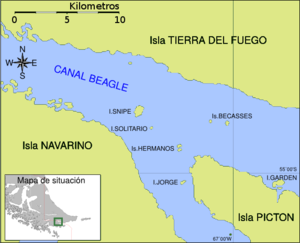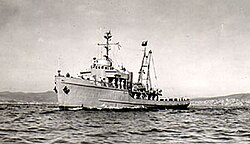
The Snipe incident was a military incident that took place between Chile and Argentina during 1958 as a result of a disputed border line in the Beagle Channel.
Both countries disagreed about the sovereign rights over the zone and Snipe, an uninhabitable islet between Picton Island and Navarino Island, claimed by both. Indeed, Chileans call the waterway around the islet Beagle Channel, but in Argentina they called it Moat channel on the grounds that the Beagle Channel, allegedly, went south around the Navarino Island. In accordance with the Beagle Channel Arbitration and the Treaty of Peace and Friendship of 1984 between Chile and Argentina, it should be called Beagle Channel.
The incident began on 12 January 1958 as the crew of the Chilean Navy transporter Micalvi built a lighthouse on the islet Snipe to improve the navigation on the channel. The beacon of the lighthouse was installed on 1 May.
In April, Isaac Francisco Rojas, at that time, Commander of Naval Operations of the Argentine Navy, ordered the destruction of the Chilean lighthouse and its replacement with an Argentine one.[1]

Patrol boat Lientur of the Chilean Navy, a former US Navy fleet tug[2]
On 11 May, the Argentine lighthouse was dismantled and transported to Puerto Williams by the crew of the Chilean patrol boat Lientur. Later, on 15 May, the same crew recovered the remains of the first Chilean lighthouse that had been removed and thrown into the sea by the crew of the Argentine patrol boat ARA Guaraní.[3]
On 8 June, a new Chilean lighthouse was installed on the islet by the crew of the Lientur.
The next day the lighthouse was shelled and destroyed by the calibre 4.7 inches main guns of the Argentine destroyer ARA San Juan, and a company of Argentine naval infantry occupied the islet to impose the Argentine claim.[4]
Despite the military buildup, a truce was agreed between the parties, that brought a return to previous status quo: no lighthouse and withdrawal of the Argentine military from the islet.[5]
Aftermath[]
The conflict over the islet (and the zone) was postponed, but Argentina maintained that the zone was disputed, and without a satisfactory solution, there would be no advance or economic use of the zone.
To confront the crisis, the Chilean government, in the last days of the second Carlos Ibáñez del Campo administration, issued the Ley Reservada del Cobre (Spanish for Cooper secret law) that provided yearly for part of state owned Codelco's copper sales, without parliamentary control, for the purchase of weapons.[6]
Twenty years later, in 1978, in order to avoid a repetition of the fait accompli, Chile placed troops on Snipe and their other islands south of the Beagle Channel before the start of Operation Soberania, Argentina's planned invasion.
The fate of Snipe islet has since been settled by the Treaty of Peace and Friendship of 1984, as an internationally recognized territory of the state of Chile. There is now a lighthouse on the islet.
See also[]
- Falklands War
- List of violent incidents at the Argentine border
- List of incidents during the Beagle conflict
- Laguna del Desierto incident
References[]
- ↑ See book of Isaac Francisco Rojas, (compiler), La Argentina en el Beagle y Atlántico sur, (1° Parte), Cap IV, section 4, page 131 :"Yo, en persona, llevé a Ushuaia una baliza luminosa, la que en la segunda quincena de abril fue instalada en el islote Snipe en lugar de la señal chilena violadora del statu quo". There is a discrepance about the dates between the testimonies of Isaac Rojas and Hugo Alsina Calderón, who says that the lighthouse was inaugurated not until 1 May.
- ↑ USS Sotoyomo-class auxiliary fleet tug
- ↑ Alsina Calderón, p. 5
- ↑ Alsina Calderón, p. 9
- ↑ See Historia General de las Relaciones Exteriores de la República Argentina Algunas cuestiones con los países vecinos
- ↑ Radseck, p. 212
Bibliography[]
- Hugo Alsina Calderón, "El incidente del islote Snipe" (in Spanish), archived from the original on 17 June 2009, http://classic-web.archive.org/web/20090617002135/http://www.revistamarina.cl/revistas/1998/1/alsina.pdf, retrieved 17 June 2009
- Alfredo Larreta (17 August 2008), "A 50 años del incidente del islote Snipe" (in Spanish), archived from the original on 15 April 2012, http://classic-web.archive.org/web/20120415052742/http://www.mercuriovalpo.cl/prontus4_noticias/site/artic/20080814/pags/20080814235111.html, retrieved 24 September 2008
- Isaac Francisco Rojas (Koordinator), La Argentina en el Beagle y Atlantico sur, (1° Parte), Editorial Diagraf. (Spanish)
- Michael Radseck, "Rohstoffe und Rüstung. Hintergründe und Wirkungen ressourcenfinanzierter Waffenkäufe in SüdamerikaLateinamerika" (in German), ILAS, pp. 203–241, archived from the original on 10 February 2012, http://classic-web.archive.org/web/20120210192744/http://www.giga-hamburg.de/dl/download.php?d=/content/publikationen/archiv/la_analysen/z_la_analysen_16_radseck.pdf, retrieved 23 September 2008
- Escudé, Carlos; Cisneros, Andrés, "Historia General de las Relaciones Exteriores de la República Argentina" (in Spanish), archived from the original on 17 February 2012, http://classic-web.archive.org/web/20120217001733/http://www.argentina-rree.com/13/13-023.htm, retrieved 23 September 2008
Coordinates: 54°57′14″S 67°8′53″W / 54.95389°S 67.14806°W
The original article can be found at Snipe incident and the edit history here.